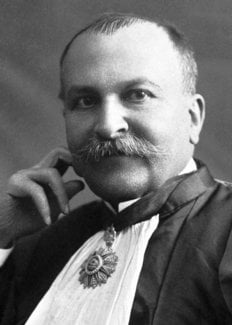Paul Sabatier
Biographical

Paul Sabatier was born at Carcassonne in Southern France on November 5, 1854. He was educated at the local Lycée and then prepared at Toulouse for the entrance examinations to the École Polytechnique and the École Normale Supérieure. He was accepted for both and chose the latter which he entered in 1874; three years later he graduated, first in his class. He taught physics for a year in a local school at Nîmes before going to the Collège de France in 1878 as assistant to Berthelot. He received the degree of Doctor of Science in 1880.
Sabatier took charge of courses in physics in the Faculty of Sciences at Bordeaux until January, 1882, when he accepted a similar post at the University of Toulouse. He additionally became responsible for courses in chemistry in 1883 and was elected Professor of Chemistry in 1884, a post which he retained until his retirement in 1930. He became Dean of the Faculty of Science in 1905 and continued to lecture after his retirement until his death in 1941. He was ever faithful to Toulouse and turned down many offers of attractive positions elsewhere, notably the succession to Moissan at the Sorbonne in 1908.
Sabatier’s earliest researches concerned the thermochemistry of sulphur and metallic sulphates, the subject for his thesis leading to his doctorate, and, in Toulouse, he continued his physico-chemical investigations to sulphides, chlorides, chromates and copper compounds. He also studied the oxides of nitrogen and nitrosodisulphonic acid and its salts and carried out fundamental research on partition coefficients and absorption spectra.
When he started his investigations into the phenomenon of catalysis, Sabatier soon pointed out anomalies in Faraday’s physical theory and he in turn formulated his chemical theory which postulated the formation of unstable intermediaries. His subsequent painstaking work and discovery of the use of finely-divided metal hydrogenation catalysts subsequently formed the bases of the margarine, oil hydrogenation, and synthetic methanol industries. He demonstrated the selectivity of catalytic action and also the selectivity of catalysts to poisons, as well as introducing the use of supports and showing the resultant enhanced activity. He also made a close study of catalytic hydration and dehydration, examining carefully the feasibility of specific reactions and the general activity of various catalysts.
Sabatier’s work is accurately recorded in the publications of learned societies and his most important book, La Catalyse en Chimie Organique (Catalysis in organic chemistry), was first published in 1913, with a second edition in 1920, of which an English translation by E.E. Reid was published in 1923.
Sabatier was a Member of the French Academy of Sciences and Commander of the Légion d’Honneur. He was Doctor of Science, honoris causa, of the University of Philadelphia and honorary member of the Royal Society of London, of the Academy of Madrid, the Royal Netherlands Academy of Sciences, the American Chemical Society, and many other foreign institutions. He was awarded the Prix Lacate (1897); the Prix Jecker (1905); the Davy Medal (1915) and Royal Medal (1918) of the Royal Society; and the Franklin Medal of the Franklin Institute (1933). For his method of hydrogenating organic compounds in the presence of finely divided metals, he was awarded the Nobel Prize in Chemistry for 1912, sharing the prize with Victor Grignard, who received it on account of his discovery of the so-called Grignard reagent.
Paul Sabatier was a very reserved man. He married Mlle. Herail and they had four daughters, one of whom married the Italian chemist, Emilio Pomilio. He was fond of art and gardening.
He died on August 14, 1941.
This autobiography/biography was written at the time of the award and first published in the book series Les Prix Nobel. It was later edited and republished in Nobel Lectures. To cite this document, always state the source as shown above.
The Nobel Foundation's copyright has expired.Nobel Prizes and laureates
Six prizes were awarded for achievements that have conferred the greatest benefit to humankind. The 14 laureates' work and discoveries range from quantum tunnelling to promoting democratic rights.
See them all presented here.
